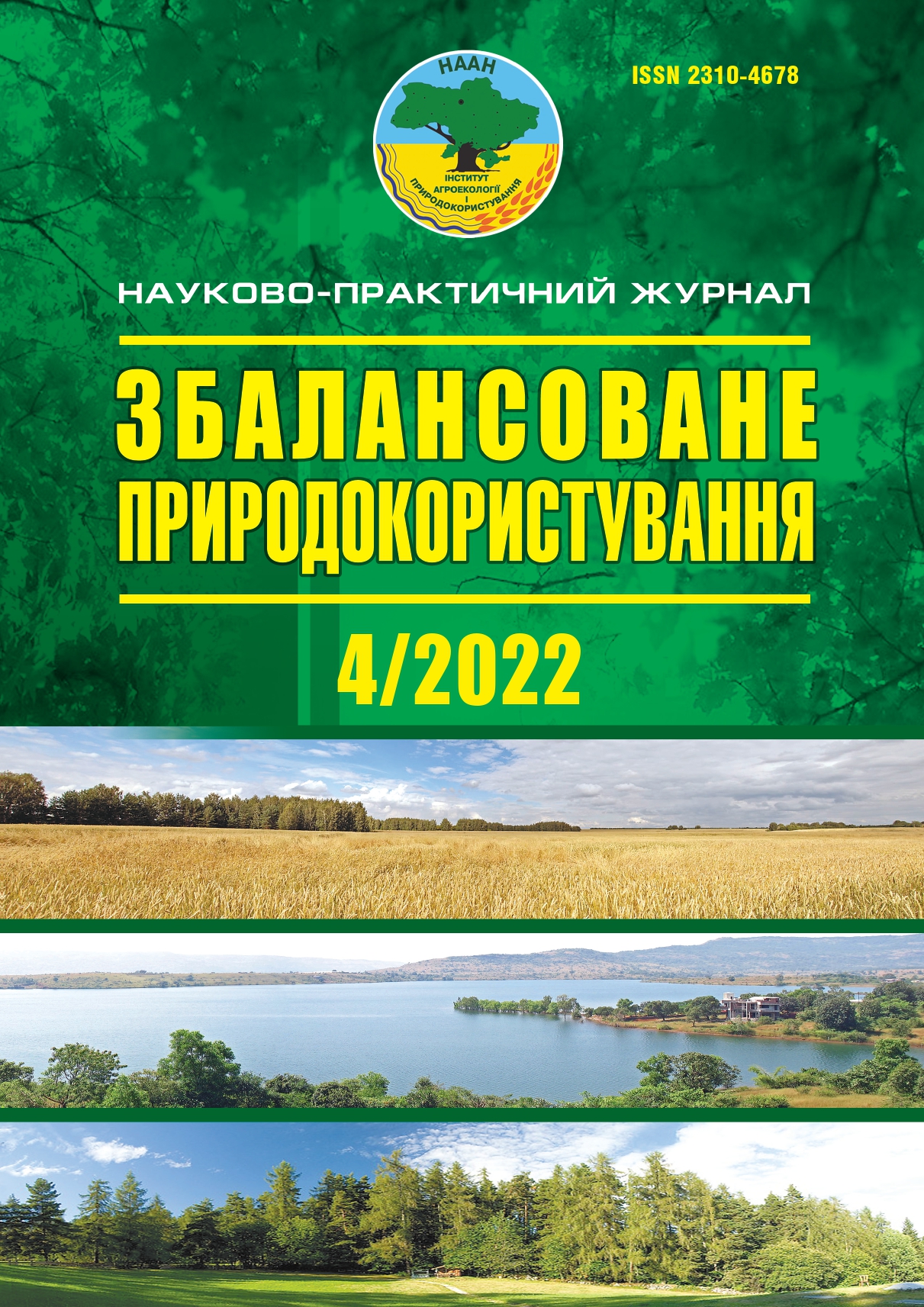Наукове обґрунтування збалансованого розвитку лікарського рослинництва
DOI:
https://doi.org/10.33730/2310-4678.4.2022.275028Ключові слова:
лікарське рослинництво, збалансований розвиток, виробництво, екологічна безпека, біологічне різноманіття, економічний потенціал, екологічна політикаАнотація
Значну роль у розвитку народного господарства сьогодні відіграє лікарське рослинництво. Його ресурсна база є цінним природним ресурсом, незамінною функціональною частиною біосфери, основою збереження потенціалу здоров’я людини. Важливим аспектом збалансованого розвитку є збереження ресурсів лікарських рослин у природних умовах їх зростання з метою збереження видового складу товарної продукції та біологічного різноманіття екосистеми. Світова тенденція, в тому числі й українська, свідчить про стрімке зростання важливості збереження видового різноманіття природної фауни та дикорослих трав зокрема. Розрізняють два напрями вирощування лікарських рослин: використання природних рослинних ресурсів (збір дикорослих видів) і вирощування лікарських рослин. Специфіка розвитку цієї галузі безпосередньо залежить від способу її ведення, для вирощування лікарської рослинної сировини сьогодні використовується близько 160 видів дикорослих рослин і близько 60 видів культурних лікарських рослин. Тобто понад 70% лікарських рослин складають фонд комплексних відновлюваних ресурсів держави, які заготовляються в Україні. Для виконання поставлених у роботі завдань використовувалися такі методи дослідження: економіко-статистичний, абстрактно-логічний, системно-структурно-порівняльний, графічний та проектно-конструктивний та ін. Сучасний стан лікарського рослинництва свідчить про значну прогалину у виробничих процесах, логістиці, екологічному менеджменті, сертифікації та інших фінансових та організаційних аспектах. Вирішення цих питань сприятиме розвитку екологізації сільського господарства, розвитку сільських територій, стабілізації обсягів вирощування лікарських рослин та регулюванню ринкових відносин з виробництва лікарських рослин. Додаткової уваги потребує систематизація пріоритетів та пошук шляхів оптимізації напрямів розвитку лікарського рослинництва з метою збалансованості. Зокрема, врахування еколого-економічних та соціальних особливостей розвитку цієї сфери передбачає вирішення проблем збереження природних ресурсів лікарських рослин, нестабільності обсягів їх заготівлі та вирощування, низької ваги екологічно чистої (від хімічного та радіаційного забруднення) якості. продукції, яка відповідає вимогам якості для її сертифікації, а також низький рівень впровадження інновацій у розвиток промисловості України.
Посилання
Official site of the International Union for the Conservation of Nature. URL: https://www.iucn.org [In English].
World Health Organization [In English] URL:http://www.who.int/home.
World Wildlife Fund [In English] URL: https://www.worldwildlife.org.
Drebot, O. & Gadzalo, A. (2016). Napriamy investytsiino innovatsiinoho mekhanizmu zbalansovanoho pryrodokorystuvannia [Areas of investment innovative mechanism of balanced nature management]. Naukovyi visnyk Khersonskoho derzhavnoho universytetu–Scientific Bulletin of Kherson State University, 3 (1), 67–71 [in Ukrainian].
International Council for Medicinal and Aromatic Plants. Official site (ICMAP). URL: https://uia.org/s/or/en/1100005658 [In English].
Suchasnyi stan ta perspektyvy vykorystannia likarskykh roslyn ta roslynnykh zasobiv, novykh perspektyvnykh likarskykh roslyn [Current state and prospects of the use of medicinal plants and herbal remedies, new promising medicinal plants]. URL: http://intranet.tdmu.edu.ua/data/kafedra/internal/pharm_new/lectures_stud/uk.htm [in Ukrainian].
Drebot, O. & Solohub, J. (2018). Svitovyi dosvid rozvytku likarskoho roslynnytstva: ekoloho-ekonomichni aspekty [World experience of medicinal plant development: ecological and economic aspects]. Zbalansovane pryrodokorystuvannia — Balanced natural use, 2, 142–146 [in Ukrainian].
Four medicines in development are accepted under the scheme. European Medicines Agency: website. URL: http://www.ema.europa.eu/ema/index.jsp?curl=pages/news_and_events/news/2016/06/news_detail_002541.jsp&mid=WC0b01ac058004d5c1 [In English].
European Union Council Directive 65/65/ЄЕС. URL: https://eur-lex.europa.eu/legal-content/EN/TXT/?uri=CELEX%3A31965L0065 [In English].
Grünwald, J. & Büttel, K. (1996). The European phytotherapeutics market. Drugs made in Germany, 39, 6–11 [In English].
Schippmann, U. & Leaman D.J. (2002). Cunningham A.B. Impact of Cultivation and Gathering of Medicinal Plants on Biodiversity: Global Trends and Issues. Rome: Inter-Departmental Working Group on Biological Diversity for Food and Agriculture. p. 225 [In English].
Bajaj, M. (1999). Conservation and trade: Is a sustainable relationship possible? Medicinal Plant Conservation, 5, 6–7[In English].
Bodeker, G., Bhat, K., Burley, J. & Vantomme, J. (1997). Medicinal plants for forest conservation and health care. Non-wood Forest Products, 11, 78–86 [In English].
Bhattarai, N., Karki, M. & Tandon, V. (2002). Report on the CAMP Workshop in Nepal, 8, 28–30 [In English].
Blanco, E. & Breaux, J. (1997). Results of the study of commercialisation, exploitation and conservation of medicinal and aromatic plants in Spain. Unpublished report for TRAFFIC Europe [In English].
Cunningham, A., Burley, J. & Vantomme, P. (1997). An African-wide overview of medicinal plant harvesting, conservation and health care. Medicinal plants for forest conservation and health care, 11, 116–129 [In English].
Cunningham, M., Cunningham, A. & Schippmann, U. (1997). Trade in Prunus africana and the implementation of CITES. German Federal Agency for Nature Conservation, Bonn [In English].
Fuller, D.O. (1991). Medicine from the wild: an overview of the U.S. native medicinal plant trade and its conservation implications. WWF/TRAFFIC USA, Washington [In English].
Goi, K., Fleurentin, J. & Todisco, M. (1997). The market for medicinal plants in France. Unpublished report for TRAFFIC Europe [In English].
Grow, S. & Schwartzman, E. (2001). The status of Guaiacum species in trade. Medicinal Plant Conservation, 7, 19–21[In English].
Bernáth, J. (1996). Situation report on the Hungarian medicinal and aromatic plant section. Unpublished report for TRAFFIC Europe [In English].
Farnsworth, N.R., Soejarto, D.D. & Akerele, O. (1991). Global importance of medicinal plants. The conservation of medicinal plants. Cambridge University Press, Cambridge [In English].
##submission.downloads##
Опубліковано
Номер
Розділ
Ліцензія
- Автори залишають за собою право на авторство своєї роботи та передають журналу право першої публікації цієї роботи на умовах ліцензії Creative Commons Attribution License, котра дозволяє іншим особам вільно розповсюджувати опубліковану роботу з обов'язковим посиланням на авторів оригінальної роботи та першу публікацію роботи у цьому журналі.
- Автори мають право укладати самостійні додаткові угоди щодо неексклюзивного розповсюдження роботи у тому вигляді, в якому вона була опублікована цим журналом (наприклад, розміщувати роботу в електронному сховищі установи або публікувати у складі монографії), за умови збереження посилання на першу публікацію роботи у цьому журналі.
- Політика журналу дозволяє і заохочує розміщення авторами в мережі Інтернет (наприклад, у сховищах установ або на особистих веб-сайтах) рукопису роботи, як до подання цього рукопису до редакції, так і під час його редакційного опрацювання, оскільки це сприяє виникненню продуктивної наукової дискусії та позитивно позначається на оперативності та динаміці цитування опублікованої роботи (див. The Effect of Open Access).


